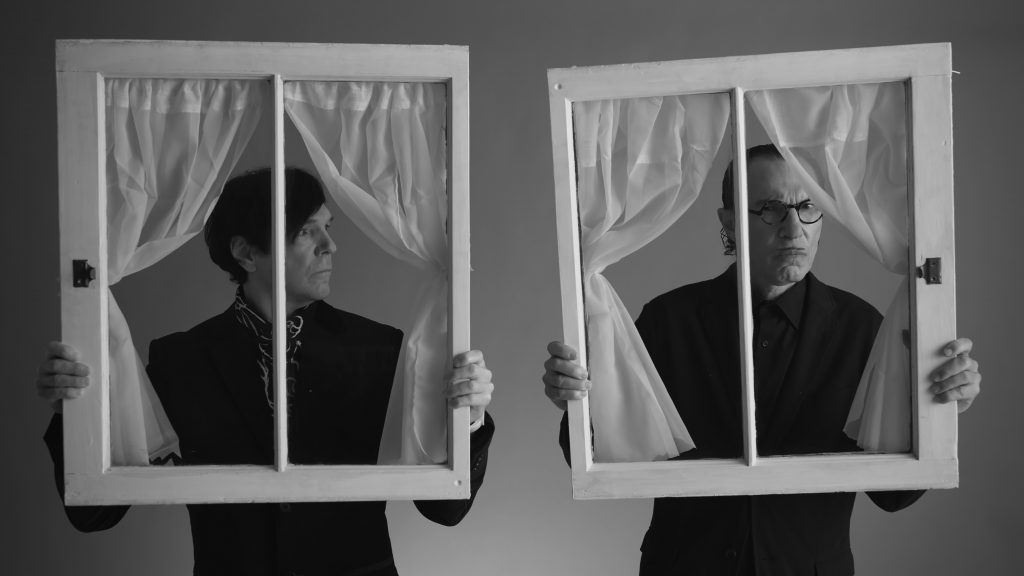March 12, 2024
by Carla Hay

“This Is a Film About the Black Keys”
Directed by Jeff Dupre
Culture Representation: The documentary film “This Is a Film About the Black Keys” features a predominantly white group of people (with a few African Americans) who are all connected in some way to the American rock duo the Black Keys and who discuss the band.
Culture Clash: The Black Keys members Dan Auerbach and Patrick Carney, who have very different personalities from each other, go through their ups and downs in their careers and their personal lives.
Culture Audience: In addition to appealing to the obvious target audience of Black Keys fans “This Is a Film About the Black Keys” will appeal primarily to people who like watching documentaries that are similar to “Behind the Music.”
“This Is a Film About the Black Keys” is a competent but not outstanding documentary that comes across as a “Behind the Music” type of promotional showcase. It has candid interviews and great archival footage, but the film has some obvious omissions in the Black Keys’ story. The documentary raises some questions that never get answered. However, the behind-the-scenes footage makes the documentary worth watching, even if you know that the filmmakers could have made more courageous choices in how this story was told.
Directed by Jeff Dupre, “This Is a Film About the Black Keys” had its world premiere at the 2024 SXSW Film and TV Festival, about a month before the release of the Black Keys’ 12th studio album “Ohio Players.” The calculated timing of both the movie’s premiere and the album’s release has “Behind the Music” influences written all over it, since most artists who’ve agreed to do a “Behind the Music” episode do it to promote a new album. That’s not necessarily a bad thing, but it usually means that the artists won’t allow the most unflattering aspects of their lives to be explored in depth in whatever documentary they’re doing to coincide with the release of a new album.
“This is a Film About the Black Keys” follows the “Behind the Music” rock band biography narrative formula, almost beat by beat: A band comes from humble beginnings, slowly builds up a fan base from releasing albums and touring, has breakthrough mainstream success, and then gets caught up in the pitfalls of fame—usually having to do with huge egos, money and substance abuse. “This is a Film About the Black Keys” checks all of those boxes.
The Black Keys have a few characteristics that set them apart from most rock artists: They are a duo when most rock artists are either solo artists or are part of band with at least three members. The Black Keys members—lead singer/guitarist Dan Auerbach and drummer Pat Carney—also don’t have a typical rock band origin story of a bunch of people forming a band because they were already friends or because they went through a lengthy search to find the right people to be in the band.
Instead, Auerbach (born in 1979) and Carney (born in 1980) say that they were more like friendly acquaintances than close friends when they started making music together. Carney and Auerbach both grew up on the same street and went to the same high school in their hometown of Akron, Ohio. The documentary dutifully covers biographical information that can be found on the Internet about the Black Keys. Carney and Auerbach are interviewed, as well as some of their family members, business associates and music industry fans.
When Auerbach and Carney were students at Firestone High School in Akron, Auerbach was a popular athlete but his real passion was music, having learned to play guitar from the age of 7. Carney says of his self-described nerdy teenage years: “I couldn’t get a girl to talk to me, so I got into rock and roll.” The “opposites attract” theme is repeated throughout the movie: Carney says he’s the extrovert who prefers to handle the duo’s business affairs and do interviews, while Auerbach is the introvert who prefers to do most of the duo’s songwriting and musical arranging.
Something that Auerbach and Carney have in common is that they both have several musicians in their families. Auerbach’s mother Mary Little says that most of her siblings are musicians. Auerbach’s cousin Robert Quine is a well-known avant-garde rock musician. Early on in their relationship, Auerbach and Carney also bonded over their admiration of musician R.L. Burnside.
As teenagers, Auerbach and Carney would occasionally play music together, but they were in different social circles in high school. Carney and Auerbach both attended the University of Akron but would eventually drop out to become full-time musicians. Auerbach says that he would skip classes in college so he could spend time in his room to play guitar. Carney describes his college years as still being at a freshman after three years of college.
Auerbach and Carney ended up forming a musical partnership in 2001. It happened after Carney had been hired to be a recording engineer for Auerbach’s band. The other musicians in the band didn’t show up, so Auerbach and Carney began jamming together and decided they could make music together as a duo. Auerbach says, “Right away, Pat and I bonded over our love of recording.” He says that they both still prefer recording over touring.
After some debate over what to call their musical act, they chose the Black Keys. The name was inspired by a friend named Alfred McMoore, who would sometimes call people the “black keys” of a piano if he was upset with them. Auerbach says in the documentary about the duo’s decision to become full-time musicians without having a record deal or a steady income: “There was no back-up plan. We had to make it work.”
By their own admission, the Black Keys have communication problems with each other. Auerbach and Carney say that they have always had difficulty talking about their problems. They say that they usually deal with their personal issues with each other by trying to ignore them. However, it causes resentment over time, which has led to periods of Auerbach and Carney being estranged from each other.
Nowhere is this communication problem more evident in the documentary than in a sequence showing Carney at a soundcheck for a Black Keys arena show while Auerbach is busy shopping for clothes. Carney is furious that his bandmate isn’t there for the soundcheck and rants about how unprofessional Auerbach is for not telling Carney and other people where Auerbach is during this soundcheck.
Meanwhile, Auerbach (accompanied by a few members of his entourage) is shown trying on high-priced clothing at a store and being treated like rock star. When the time comes for the Black Keys to do the concert, Auerbach and Carney are standing next to each backstage but don’t talk about Auerbach’s soundcheck absence that was upsetting to Carney. For this concert, Auerbach is wearing the jacket that he bought at the store.
The Black Keys’ slow and steady rise to Grammy-winning, arena-rock success is a familiar tale of “alternative rock” artists who want a lot of praise, recognition and money for what they do, but they don’t want to be perceived as “sell-outs” or fake. They also want to be able to experiment musically without alienating their core fan base. John Peets, a former manager of the Black Keys, says of the Black Keys’ musical outlook: “They are a fiercely independent band.”
The Black Keys were independent in the beginning of their career, having signed with a series of independent labels and producing their own albums. The band began getting positive reviews from their first album—2002’s “The Big Come Up”—and toured relentlessly for their albums. Carney did a lot of the duo’s bus driving and tour managing in the early days of the Black Keys. He’s the raconteur who is more likely than Auerbach to tell stories in the documentary about their experiences with dingy motels, low-paying gigs, and travel mishaps on the road.
In the early years of the Black Keys, their personal lives of the Black Keys also had parallels to their professional lives. Auerbach and Carney both got married to their first wives around the same time: Carney married his high-school sweetheart Denise Grollmus in 2007. Auerbach married Stephanie Gonis in 2008. Both marriages ended in very messy and public divorces—Carney and Grollmus split in 2009, while Auerbach and Gonis broke up in 2013, with their divorce becoming final in 2014. In the documentary, the divorces are described in vague terms that essentially amount to saying “irreconcilable differences” or “growing apart.”
The details of these divorces are left out of the documentary, but there is a little bit of acknowledgement in the movie about how these divorces affected the Black Keys’ work: By Carney’s own admission, he began drinking alcohol a lot more during his divorce from Grollmus, thereby making the recording of the Black Keys’ 2010 album “Brothers” much more difficult. It’s also mentioned that Auerbach’s divorce from Gonis had a big influence on the emotionally raw and wounded lyrics of the Black Keys’ 2014 album “Turn Blue,” the album that nearly broke up the Black Keys because it was made during a low point in the relationship between Carney and Auerbach. In retrospect, Carney says that during this tumultuous time, the Black Keys probably should have gone on vacation instead of doing an album and tour.
Gonis is the only wife or ex-wife interviewed in the documentary. Her comments that are in the movie mostly describe when her relationship with Auerbach was going well. However, she says their divorce happened because she and Auerbach drifted apart because of all the time he spent away from home. Gonis jokes about their “shotgun wedding” and says that although Auerbach is a loving father, she felt like a single mother raising their daughter Sadie Little Auerbach, who was born in 2008 and is seen briefly in archival footage.
The documentary does not mention any of the sordid information that was widely reported about the divorce filings, such as Gonis’ allegations that Auerbach abused her, or Auerbach’s allegations that Gonis attempted suicide twice in one day. Auerbach was married to Jen Goodall from 2015 to 2019. He is not forthcoming about what really happened in the failures of his two marriages. It isn’t too surprising that Auerbach is unwilling to talk about his personal problems in a biographical documentary that is largely about his life, since he is frequently described in the documentary as being secretive and mysterious, even by people who’ve known him for a very long time.
A turning point for the Black Keys came in 2007, when they collaborated with a pop music producer for the first time: Danger Mouse, whose real name is Brian Joseph Burton. At the time, it seemed to be an unlikely collaboration: Danger Mouse was a Grammy-winning hitmaker best known for the Gnarls Barkley’s 2006 R&B/pop smash “Crazy.” However, Carney says he fell in love with the song, which he describes as “cinematic.” The result of the first collaboration between the Black Keys and Danger Mouse was the Black Keys’ 2008 album “Attack & Release.”
The Black Keys went on to get an even larger audience with their 2010 mainstream breakthrough album “Brothers,” which featured the hit “Tighten Up.” It was the first album the Black Keys released after the duo relocated to Nashville and after collaborating again with Danger Mouse. The Black Keys won three Grammys because of “Brothers” and won another three Grammys for their 2011 album “El Camino,” which featured the hit “Lonely Boy.”
Although Carney comes across as the more socially confident than Auerbach, Carney admits that behind the scenes, he’s had longtime insecurities about his place in the Black Keys, because Auerbach has often treated him as a backup musician instead of as an equal. One of the biggest rifts that they had was in the mid-2010s, when Auerbach recorded his first solo album without telling Carney, who thinks that this secrecy was a betrayal to Carney. Auerbach says in the documentary that the reason for the secrecy was that Carney was “impossible to be around” at that time. Perhaps one of the more honest moments in the documentary is Carney expressing his fear that he is replaceable in the Black Keys.
The Black Keys’ personal problems within themselves, with each other and in their marriages get uneven exploration in the documentary. Carney’s drinking problem that severely affected the recording of “Brothers” is mentioned but somewhat glossed over. No one comes right out and says that Carney is an alcoholic, but that’s something the documentary filmmakers should have asked Carney. The documentary also doesn’t mention if Carney every got professional help for his drinking problem.
Carney’s marital problems are also described in generic terms or not mentioned at all. He admits that his divorce from first ex-wife Grollmus was bitter, but he barely mentions his second ex-wife Emily Ward, whom he was married to from 2012 to 2016. Carney’s third wife is Grammy-winning singer/songwriter Michelle Branch, whom he married in 2019. Their scandalous separation in 2022 and subsequent reunion—Branch publicly accused him of infidelity, filed for divorce, and then decided to call off the divorce—are not mentioned at all. In the documentary, Carney is briefly shown spending time with his and Branch’s son Rhys James (born in 2018), who appears in some Black Keys rehearsal footage.
A documentary does not need to go the tabloid route and air a lot of dirty laundry. But when a celebrity documentary is made about a celebrity’s life, and several people in the documentary say the celebrity’s personal problems directly affected the celebrity’s work, it behooves the documentary filmmakers to get more details and introspection from the people who caused the problems or were directly affected by the problems. It’s especially noticeable that the documentary doesn’t seem to care to mention if Carney got professional help for what many people describe in the documentary as his alcohol addiction.
In a director’s statement in the movie’s production note, Dupre says about the making of this documentary: “I was going to need Pat and Dan to tell me everything. What they told me first was that they weren’t always very good at communicating with each other. Would they open up to me? I soon realized I wouldn’t need to lean on them quite as much as I thought I would because their music would speak volumes if we let it.”
Dupre further commented in the statement: “Want to know who they were and what they were feeling at every step of the way? Listen to their songs. That became the operating principle in the editing room: as much as possible, let their music tell the story and drive the narrative. … Pat and Dan did open up and come through in their interviews … in spades. But their incredible music expresses who they are and what they’ve been through beyond talk and beyond words.”
That’s all well and good, but “This Is a Film About the Black Keys” is not a concert documentary or a documentary about the making of an album. It’s supposed to be a biographical documentary that looks at all aspects of their lives, but the movie comes across as playing it a little too safe, as if the filmmakers wanted the approval of the Black Keys’ publicity team too. The documentary has very good concert scenes, but gives very little insight into the inspirations or recordings of specific Black Keys songs.
The people interviewed in the documentary do not include any critics of the Black Keys. Oher interviewees include Dan Auerbach’s father Chuck Auerbach; Patrick Carney’s brother Michael Carney; Fat Possum Records executives Matthew Johnson and Bruce Watson; Grammy-winning singer/songwriter Beck; and journalist Peter Relic, who gave the Black Keys’ their first review in Rolling Stone magazine.
The Black Keys’ notorious feud (which has since been settled) with Jack White (formerly of the rock duo the White Stripes) is not mentioned at all in the documentary. The closest thing that the documentary will mention to any music feuds that the Black Keys had was when Carney got some social media hate from Justin Bieber fans in 2013, when a reporter asked Carney to comment on Bieber not getting any Grammy nominations that year, and Carney made a flippant comment that Bieber should be happy with being rich. This short-lived and petty trolling from angry Bieber fans is quickly laughed off in the documentary for what is. But if you believe everything in this documentary, the Black Keys never had any uncomfortable rivalries with other musicians, when the reality is that they did.
People can enjoy the Black Keys’ music in any number of ways, including this documentary. As entertaining it might be to look at the impressive array of archival Black Keys footage that the documentary has compiled, the movie’s overall story of the Black Keys looks very much like a sympathetically slanted portrait of how the Black Keys want to see themselves and not a complete story of who they really are. Based on the final results, the documentary filmmakers seemed all too willing to go along and leave perhaps the hardest parts of the Black Keys’ story left untold.


